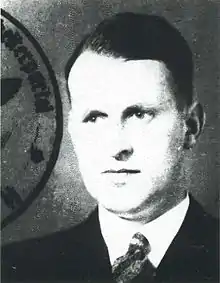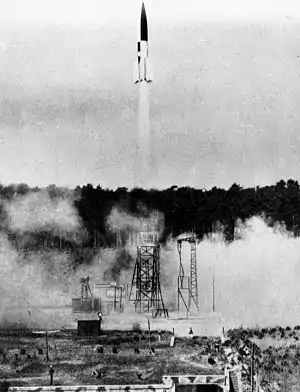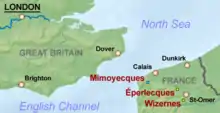Hans Kammler
Hans Kammler (26 August 1901 – 9 May 1945[lower-alpha 1]) was an SS-Obergruppenführer responsible for Nazi civil engineering projects and its top secret weapons programmes. He oversaw the construction of various Nazi concentration camps before being put in charge of the V-2 rocket and jet programmes towards the end of World War II. In May 1945 Kammler disappeared in the final days of the war. Despite numerous theories, his fate remains an unsolved mystery.
Hans Kammler | |
|---|---|
 NSDAP ID photograph, 1932 | |
| Born | 26 August 1901 Stettin, German Empire |
| Died | 9 May 1945 (aged 43) legally declared date near Prague |
| Allegiance | |
| Service/ | SS |
| Rank | SS-Obergruppenführer und General der Waffen-SS |
| Commands held | Office D within the SS Main Economic and Administrative Office |
Early life
Kammler was born in Stettin, German Empire (now Szczecin, Poland). In 1919, after volunteering for army service, he served in the Rossbach Freikorps. From 1919 to 1923, he studied civil engineering at the Technische Hochschule der Freien Stadt Danzig and Munich and was awarded his Dr.-Ing. in November 1932, following some years of practical work in local building administration.[1]
In 1931, Kammler joined the Nazi Party (NSDAP) where he held a variety of administrative positions after the Nazi government came to power in 1933. Initially he was head of the Aviation Ministry's building department.[2] He joined the SS (no. 113,619) on 20 May 1933. In 1934, he was a councillor for the Reich Interior Ministry.
In 1934, he was also made the leader of the Reichsbund der Kleingärtner und Kleinsiedler (Reich's federation of allotment gardeners and small home owners).[3]
World War II
In June 1941, Kammler joined the Waffen-SS.[2] After becoming Oswald Pohl's deputy at the SS Main Economic and Administrative Office (WVHA), he worked with SS-Gruppenfuhrer Richard Glücks) of Office D (Concentration Camps Inspectorate), and was also Chief of Office C, which designed and constructed all the concentration and extermination camps. In this capacity he oversaw the installation of more efficient cremation facilities at Auschwitz-Birkenau as part of the camp's conversion to an extermination camp.[4][5]
Advanced weapon projects


Kammler is know to have been associated with the Nazi's advanced weapon projects in 1942. Early evidence of this is a letter - in which Kammler is named - from Pohl to Reichsführer-SS Heinrich Himmler which refers to an interdepartmental memorandum on the manufacture of weapons in concentration camps.
Kammler was charged with constructing facilities for various secret weapons projects, including manufacturing plants and test stands for the Messerschmitt Me 262 and V-2. Following the successful Allied bombing raids on Peenemünde in August 1943, Kammler assumed responsibility for the construction of V-2 mass-production facilities by moving them underground.[2] In July 1944 the Mittelwerk facility near Nordhausen began operation under the Kohnstein, a hill in Thuringia, Germany. The tunnels were built in horendous conditions by slave labour from the Mittelbau-Dora concentration camp. Research has found that of the 60,000 people who passed through Mittelbau-Dora and its subcamps, an estimated 20,000 died; 350 were hanged (including 200 for sabotage), while many others died from exhaustion, cold, malnutrition, disease, or murdered by the SS guards.[6] Kammler's attitude towards the prisoners was: "Don't worry about the victims. The work must proceed ahead in the shortest time possible".[7]
Reich Ministry of Armaments and War Production, Albert Speer made Kammler his representative for "special construction tasks", expecting that Kammler would commit himself to working in harmony with the ministry's main construction committee. But in March 1944 Kammler had Göring appoint him as his delegate for "special buildings" under the fighter aircraft programme, which made him one of the war economy's most important managers, and robbed Speer of much of his influence.[8]
Kammler was also involved in an attempt to finish the Blockhaus d'Éperlecques near Saint-Omer, Pas-de-Calais in Northern France. The fortified bunker was to be used as a V-2 launch base but it was abandoned in September 1944 before it was finished.[9]
In March 1944, Himmler convinced Adolf Hitler to put the V-2 project directly under SS control. On 8 August Kammler replaced Walter Dornberger as its director taking command and control of V-2 operations. The first rockets were launched from The Hague against London on 8 September 1944.[10] From 31 January 1945, Kammler was head of all missile projects.[2] During this time he also partially answerable for the operational use of the V-2 against the Allies, until the moment the war front reached Germany's borders. There are several contradictory testimonies on how far and how deep he commanded the bombardments of London and Antwerp but it is well known he played an active role on the deployment and maintenance of the units involved in the operations, frequently through Dornberger. A quite symbolic fact of his involvement may be that he gave the orders to reorganize the V-2 units into regular infantry units.[11]
In March 1945, Hitler stripped Goering of his powers on aircraft support, maintenance and supply and transferred these duties to Kammler. This culminated, in the beginning of April, with Kammler being raised to "Fuehrer's general plenipotentiary for jet aircraft".[8] He would be last person in Nazi Germany to be appointed to the rank of Obergruppenführer.[12]
Arnsberg Forest Massacre
In late March 1945 Kammler ordered the ZV division (in German) (units that operated the V-2 rockets) to execute forced laborers and their families (200 men, women and children) after his car was held up on a crowded road in the Sauerland. Kammler was reported to have felt he was under some "vague threat" so "this riffraff ought to be eliminated".[13] The killings coincided with the evacuation of V2 units due to the Allied advance into Germany. According to statements made by two former SS personnel from ZV Division in 1958 during their trial for killing the Soviet and Polish workers and their families, Kammler issued the direct orders for the massacre.[14] After the massacre, the ZV division destroyed its V-2 equipment and became an infantry unit.
Several scientific studies have been undertaken at the location to understand the nature of the massacre.[15][16]
Disappearance and death
On 1 April 1945, Kammler ordered the evacuation of 500 missile technicians to the Nazi's Alpine Fortress. Since the last V-2 on the western front had been launched in late March, on 5 April Kammler was charged by the Oberkommando der Wehrmacht to command the defence of the Nordhausen area. However, rather than defend the missile construction works, he immediately ordered the destruction of all the "special V-1 equipment" at the Syke storage site.[2]
In the final weeks of the war in Europe, Kammler's movements become sketchy and contradictory. Wernher von Braun said Kammler was in Oberammergau, Bavaria in April 1945. The nazi rocket scientist later reported having overheard a discussion between Kammler and his aide-de-camp in which Kammler said he planned to hide in nearby Ettal Abbey. Kammler and his followers then left town, according to von Braun.[2] Further evidence of Kammler's activities is a telegraph from Kammler to Speer, Himmler and Göring of 16 April, informing them of the creation of a "message centre" at Munich and the appointment of a chief representative for the construction of the Messerschmitt Me 262. On 20 April, he reportedly arrived with a group of technicians at Himmler’s Kommandostelle near Salzburg. On 23 April, Kammler sent a radio message to his office manager at Berlin, ordering him to organize the immediate destruction of the "V-1 equipment near Berlin" and then to go to Munich.[2]
A wartime diary, relating to the surrender of the mountain resort town Garmisch-Partenkirchen to Allied troops, mentions Kammler and his staff.[17] It said that Kammler and his staff of some 600 personnel, with "good quality" cars and trucks arrived in Oberammergau (north of Garmisch-Partenkirchen) on 22 April 1945 but their arrival was badly received by the local authorities who had several arguments with Kammler himself. These conflicts are referenced in the entries for 23 and 25 April. The last reference, implicating only Kammler's "staff", comes on the night of 28 April – an Oberleutnant Burger reports that they had gone on the same night that American forces began entering Oberammergau.[18]
In late April/early May, Kammler was reportedly at the Villa Mendelssohn at Ebensee, site of one of the projects assigned to him. On 4 May, he ordered the immediate transfer of the Ebensee office to Prague.[2]
In a sworn statement on 16 October 1959, Kammler's driver, Kurt Preuk stated that Kammler's date of death was "about 10 May 1945", but that he did not know the cause of death. On 7 September 1965, Heinz Zeuner (a wartime aide of Kammler's), stated that Kammler had died on 7 May 1945 and that his corpse had been observed by Zeuner, Preuk and others. All the eyewitnesses consulted were certain that the cause of death was cyanide poisoning.[19] In their accounts of Kammler's movements Preuk and Zeuner claimed that he left Linderhof near Oberammergau on 28 April 1945 for a tank conference at Salzburg and then went to Ebensee (where tank tracks were manufactured). According to Preuk and Zeuner he then travelled back from Ebensee to visit his wife in the Tyrol region, when he gave her two cyanide tablets. The next day, 5 May, at around 4 am, he is said to have departed Tyrol for Prague.[2]
In a 1969 book Wernher von Braun: Mein Leben für die Raumfahrt, author Bernd Ruland claimed Kammler arrived in Prague by aircraft on 4 May 1945, following which he and 21 SS men defended a bunker against an attack by more than 500 Czech resistance fighters on 9 May. During the attack, one of Kammler's aide-de-camps shot Kammler to prevent his capture.[20] This version can reportedly be traced to Walter Dornberger, who in turn is said to have heard it from eyewitnesses.[21]
Official verdict
On 9 July 1945, Kammler's wife petitioned to have him declared dead as of 9 May 1945. She provided a statement by Kammler's driver, Kurt Preuk, according to which Preuk had personally seen "the corpse of Kammler and been present at his burial" on 9 May 1945. The District Court of Berlin-Charlottenburg ruled on 7 September 1948 that his death was officially established as 9 May 1945.[2]
Both Preuk and Zeuner maintained their version of events when interviewed in the 1990s. Some support for this version of events came from letters written by Ingeborg Alix Prinzessin zu Schaumburg-Lippe, a female member of the SS-Helferinnenkorps to Kammler’s wife in 1951 and 1955. In these, she affirmed that Kammler had said goodbye to her on 7 May 1945 in Prague, stating that the Americans were after him, had made him offers but that he had refused and that they would not "get him alive".[2]
Post-war searches
US occupation forces conducted various inquiries into Kammler’s whereabouts, beginning with the headquarters of 12th Army ordering a complete inventory of all personnel involved in missile production on 21 May 1945. This resulted in the creation of a file for Kammler, stating that he was possibly in Munich. The CIC noted that he had been seen shortly prior to the arrival of US troops in Oberjoch.[22]
The Combined Intelligence Objectives Sub-Committee (CIOS) in London ordered a search for him in early July 1945. 12th Army replied that he was last seen on 8 or 9 April in the Harz region. In August, Kammler's name made "List 13" of the UN for Nazi war criminals. Only in 1948 did the CIOS receive the information that Kammler reportedly fled to Prague and had committed suicide. Original blueprints of Kammler’s major projects were later found in the personal property of Samuel Goudsmit, the scientific leader of the Alsos Mission.[22]
In 1949 a report written by one Oskar Packe on Kammler was filed by the US Denazification office in Hesse. The report stated that Kammler had been arrested by US troops on 9 May 1945 at the Messerschmitt works at Oberammergau. However, Kammler and some other senior SS personnel had managed to escape in the direction of Austria or Italy. Packe disbelieved the reports about a suicide, as these were "refuted by the detailed information from the CIC" about arrest and escape.[22]
A CIC report from April 1946 listed Kammler among SS officers known to be outside Germany and considered to be of special interest to the CIC. In mid-July 1945, the head of the Gmunden CIC office, Major Morrisson interviewed an unnamed German on the issue of a numbered account associated with construction sites for plane and missile production formerly run by the SS. A report published years later, in late 1947 or early 1948, stated that only Kammler and two other persons had access to the account. The report also said that "shortly after the occupation, Hans Kammler appeared at CIC Gmunden and gave a statement on operations at Ebensee".[23] The CIC notes on the interview give no name, but the interviewee must have been one of the three people with access to the account. Aside from Kammler, one was known to have left Austria in May 1945, the other was in a POW camp during July.[22]
Finally, Donald W. Richardson (1917–1997) a former OSS special agent involved in the Alsos Mission, claimed to be "the man who brought Kammler to the US".[23] Shortly before he died, Richardson reportedly told his sons about his experience during and after the war, including Operation Paperclip. According to them, Richardson claimed to have supervised Kammler until 1947. Kammler was supposedly "interned at a place of maximum security, with no hope, no mercy and without seeing the light of day until he hanged himself".[22]
See also
Notes
- Declared legally dead in 1948.
References
- Tooze 2007, p. 209.
- Karlsch 2014, p. 52.
- "Blut- und Bodenideologie – die Landesgruppe Sachsen im Reichsbund der Kleingärtner und Kleinsiedler Deutschlands (1933–1945) (German)" (PDF).
- van Pelt 2002, p. 209.
- Post 2004.
- Cooksley, Peter G (1979). Flying Bomb. New York: Charles Scribner’s Sons. p. 175.
- Bornemann & Broszat 1970, p. 165.
- Kroener 2003, p. 390.
- Aulich, Jim (2007). "Memory, What is it Good For? Forced Labour, Blockhouses and Museums in Nord-Pas de Calais, Northern France". In Aulich, Jim; Dawson, Graham; Purbrick, Louise (eds.). Contested Spaces: Sites, Representations and Histories of Conflict. Palgrave Macmillan. ISBN 978-0-230-01336-0.
- Collier, Basil (1976). The Battle of the V-Weapons. Morley, The Elmfield Press. pp. 113, 170.
- Dungan.
- Dienstalterslisten der SS, NSDAP Revised edition (20 April 1945)
- Stargardt, Nicholas (2016). The German War: A Nation Under Arms, 1939-45. Penguin Random House. p. 517. ISBN 9780099539872.
- "Who was this notorious & mysterious SS general, he just vanished in May '45". www.warhistoryonline.com. 17 January 2019.
- Solly 2019.
- Dvorsky 2019.
- Gais 1945.
- Utschneider 2000.
- Naasner 1998, p. 341.
- Ruland 1969, p. 292.
- Piszkiewicz 2007, p. 215.
- Karlsch 2014, p. 53.
- "La fuga segreta del custode dell'atomica nazista – la Repubblica.it". La Repubblica (in Italian). Retrieved 15 November 2014.
Sources
- Agoston, Tom (1985). Blunder!: How the U.S. Gave Away Nazi Supersecrets to Russia. Dodd, Mead. ISBN 0-396-08556-3.
- Bornemann, Manfred; Broszat, Martin (1970). "Das KL Dora-Mittelbau". Studien zur Geschichte der Konzentrationslager. Schriftenreihe der Vierteljahrshefte für Zeitgeschichte (in German). Stuttgart. 21: 154–198. doi:10.1524/9783486703627.154. ISBN 978-3-486-70362-7.
- Farrell, Joseph P. (2005). Reich of the Black Sun: Nazi Secret Weapons & the Cold War Allied Legend. Adventures Unlimited Press. ISBN 1-931882-39-8.
- Dungan, T. "A4/V2 Launch Sites in Westerwald, Germany". Retrieved 16 October 2019.
- Solly, Meillan (15 March 2019). "400 Artifacts Unearthed at Site of Nazi Massacre Targeting Polish, Soviet P.O.W.s". Retrieved 16 October 2019.
- Dvorsky, Georg (12 March 2019). "Hundreds of Artifacts from Notorious Nazi Massacre Uncovered in German Forest". Retrieved 16 October 2019.
- Gais, Huber (15 May 1945). "Ein Kriegsende – Garmisch-Partenkirchen in den letzten Apriltagen 1945". Archived from the original on 1 November 2013. Retrieved 30 October 2013.
- Karlsch, Rainer (2014). "Was wurde aus Hans Kammler? (summary of an article in Zeitschrift für Geschichtswissenschaft, Heft 6, 2014)". Frankfurter Allgemeine am Sonntag (in German). Frankfurt: 52–53.
- Kroener, Bernhard R (2003). Wartime Administration, Economy, and Manpower Resources 1942 – 1944/5. Oxford University Press. ISBN 0-19-820873-1.
- Naasner, Walter (1998). SS-wirtschaft und SS-verwaltung (in German). Droste. ISBN 3-7700-1603-3.
- Piszkiewicz, Dennis (2007). The Nazi Rocketeers: Dreams of Space and Crimes of War. Stackpole Books. ISBN 978-0-8117-3387-8.
- Post, Bernhard (16 December 2004). "80,000 Cremation Capacity Per Month Not Sufficient for Auschwitz – New Document". The Holocaust History Project. Archived from the original on 1 April 2012. Retrieved 27 August 2013.
- Ruland, Bernd (1969). Wernher von Braun: Mein Leben fur die Raumfahrt (in German). Offenburg: Burda Verlag.
- Tooze, Adam (2007). The Wages of Destruction: The Making and Breaking of the Nazi Economy. New York: Viking. ISBN 978-0-670-03826-8.
- Utschneider, Ludwig (2000). "Rüstungsindustrie in Oberammergau im Zweiten Weltkrieg" (in German). Historical Society of Oberammergau. Retrieved 30 October 2013.
- van Pelt, Robert Jan (2002). The Case for Auschwitz: Evidence From the Irving Trial. Bloomington: Indiana University Press. ISBN 978-0-253-34016-0.